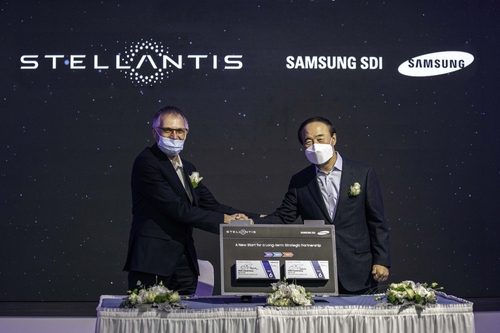Jeep-maker Stellantis and South Korean tech manufacturer Samsung SDI have confirmed plans to build a new electric vehicle battery plant, slated to launch in 2027.
The facility is the second project to come from the Stellantis-SDI joint venture. Last year, the two companies finalized an agreement to construct an electric vehicle battery plant in Indiana with an estimated price tag of $3.1 billion and an opening date in 2026. While both companies are still negotiating details such as the new site’s location and cost, it is expected to launch with an energy output of 34 gigawatt hours (GWh), slightly greater than the 30 GWh anticipated from the Indiana location. A separate factory in Canada, which the automaker is constructing in partnership with a different South Korean company, LG Energy Solution, is also scheduled to open next year with a 45 GWh capacity.
Stellantis CEO Carlos Tavares stated that the new factory would “contribute to reaching our aggressive target to offer at least 25 new battery electric vehicles for the North American market by the end of the decade.” Under Tavares’s leadership, the car manufacturer has fallen slightly behind other industry leaders in electrification, although not to the extent of Japanese brands such as Toyota.
However, 2022 and 2023 have seen a rapidly intensifying onslaught of new construction projects, especially in the U.S., where Ford and General Motors are looking to outpace the electric vehicle segment’s current top producer, Tesla. The possibility of falling behind its American competitors has likely encouraged Stellantis to take the EV market more seriously, in addition to its recovering financial situation following the COVID pandemic. Stellantis recently ended a nearly two-year streak of declining sales by posting a 6% gain in the second quarter.
Like many automakers, Stellantis and Samsung SDI are prioritizing the electric vehicle battery supply chain before diverting too much attention toward the research and development of new models. EVs remain a niche market, suffocated by high material costs and missing infrastructure. The sooner car manufacturers can open new factories, the faster they can scale their EV operations to boost adoption and remain in compliance with government emissions targets.




